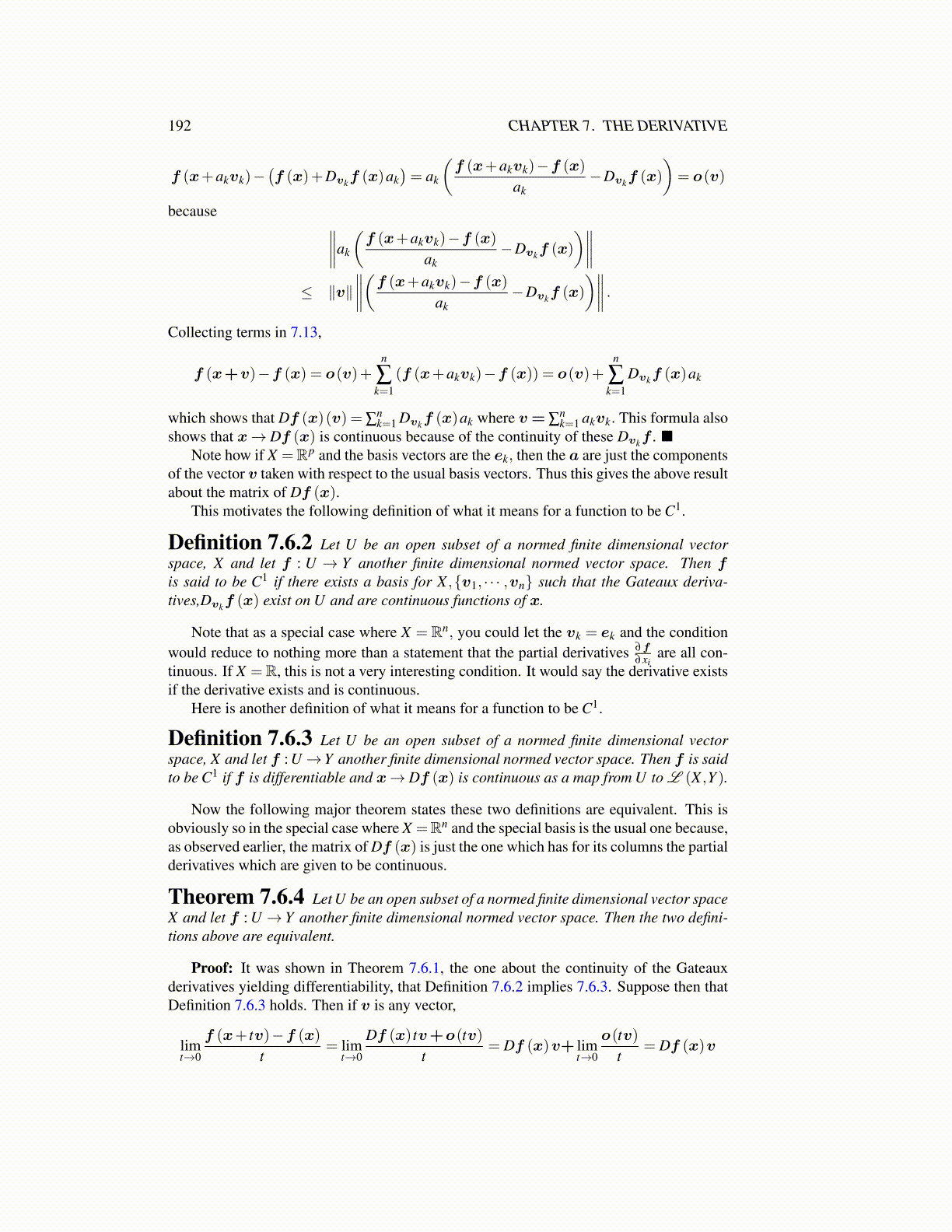
192 CHAPTER 7. THE DERIVATIVE
f (x+akvk)−(f (x)+Dvkf (x)ak
)= ak
(f (x+akvk)−f (x)
ak−Dvkf (x)
)= o(v)
because ∥∥∥∥ak
(f (x+akvk)−f (x)
ak−Dvkf (x)
)∥∥∥∥≤ ∥v∥
∥∥∥∥(f (x+akvk)−f (x)ak
−Dvkf (x)
)∥∥∥∥ .Collecting terms in 7.13,
f (x+v)−f (x) = o(v)+n
∑k=1
(f (x+akvk)−f (x)) = o(v)+n
∑k=1
Dvkf (x)ak
which shows that Df (x)(v) = ∑nk=1 Dvkf (x)ak where v= ∑
nk=1 akvk. This formula also
shows that x→ Df (x) is continuous because of the continuity of these Dvkf . ■Note how if X =Rp and the basis vectors are the ek, then the a are just the components
of the vector v taken with respect to the usual basis vectors. Thus this gives the above resultabout the matrix of Df (x).
This motivates the following definition of what it means for a function to be C1.
Definition 7.6.2 Let U be an open subset of a normed finite dimensional vectorspace, X and let f : U → Y another finite dimensional normed vector space. Then fis said to be C1 if there exists a basis for X ,{v1, · · · ,vn} such that the Gateaux deriva-tives,Dvkf (x) exist on U and are continuous functions of x.
Note that as a special case where X = Rn, you could let the vk = ek and the conditionwould reduce to nothing more than a statement that the partial derivatives ∂f
∂xiare all con-
tinuous. If X =R, this is not a very interesting condition. It would say the derivative existsif the derivative exists and is continuous.
Here is another definition of what it means for a function to be C1.
Definition 7.6.3 Let U be an open subset of a normed finite dimensional vectorspace, X and let f : U→Y another finite dimensional normed vector space. Then f is saidto be C1 if f is differentiable and x→Df (x) is continuous as a map from U to L (X ,Y ).
Now the following major theorem states these two definitions are equivalent. This isobviously so in the special case where X =Rn and the special basis is the usual one because,as observed earlier, the matrix of Df (x) is just the one which has for its columns the partialderivatives which are given to be continuous.
Theorem 7.6.4 Let U be an open subset of a normed finite dimensional vector spaceX and let f : U → Y another finite dimensional normed vector space. Then the two defini-tions above are equivalent.
Proof: It was shown in Theorem 7.6.1, the one about the continuity of the Gateauxderivatives yielding differentiability, that Definition 7.6.2 implies 7.6.3. Suppose then thatDefinition 7.6.3 holds. Then if v is any vector,
limt→0
f (x+ tv)−f (x)t
= limt→0
Df (x) tv+o(tv)t
= Df (x)v+ limt→0
o(tv)t
= Df (x)v